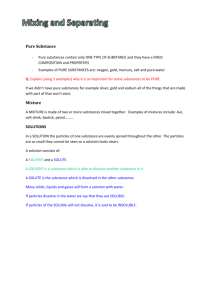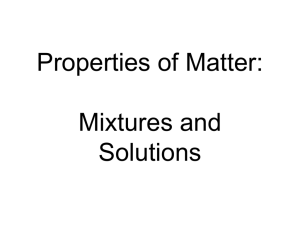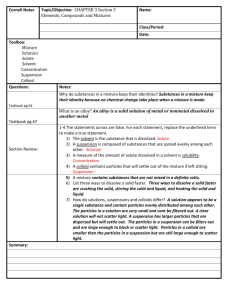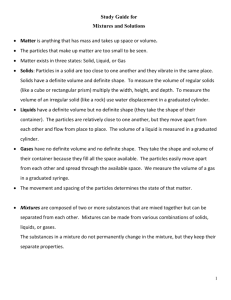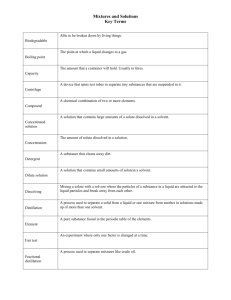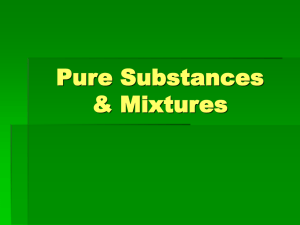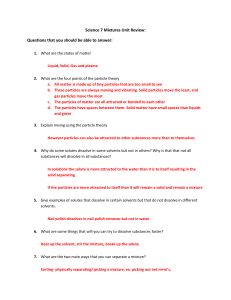Mixtures and Solution Notes
advertisement
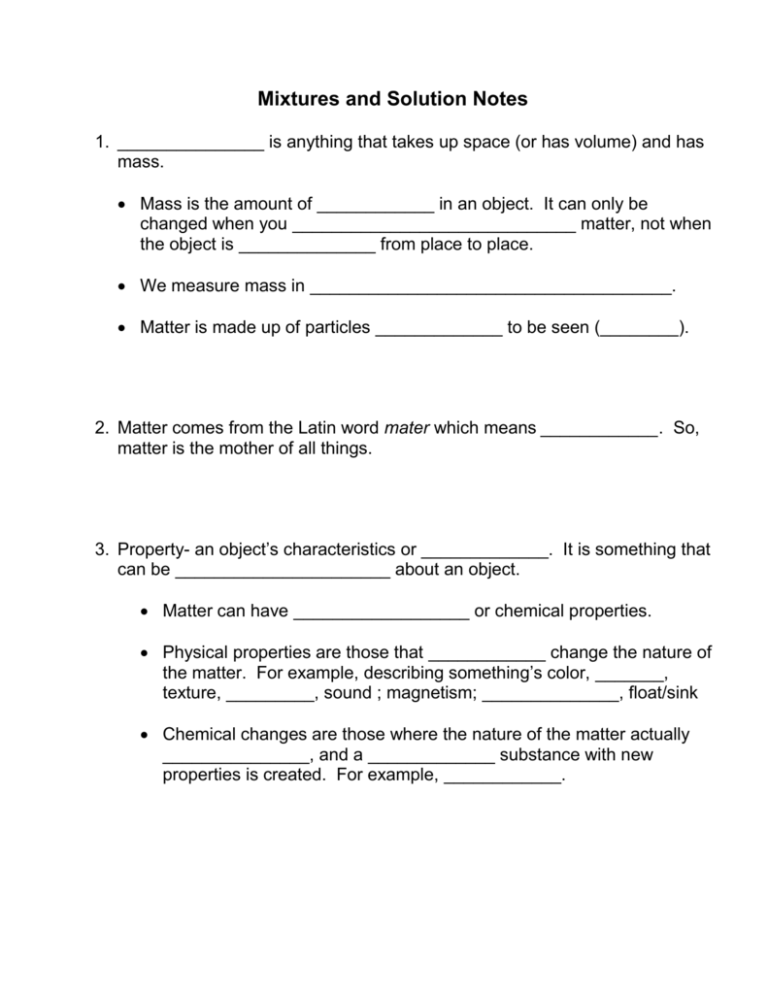
Mixtures and Solution Notes 1. _______________ is anything that takes up space (or has volume) and has mass. Mass is the amount of ____________ in an object. It can only be changed when you _____________________________ matter, not when the object is ______________ from place to place. We measure mass in _____________________________________. Matter is made up of particles _____________ to be seen (________). 2. Matter comes from the Latin word mater which means ____________. So, matter is the mother of all things. 3. Property- an object’s characteristics or _____________. It is something that can be ______________________ about an object. Matter can have __________________ or chemical properties. Physical properties are those that ____________ change the nature of the matter. For example, describing something’s color, _______, texture, _________, sound ; magnetism; ______________, float/sink Chemical changes are those where the nature of the matter actually _______________, and a _____________ substance with new properties is created. For example, ____________. 4. Matter can be classified in different ways: By its _______________ Whether it is a substance or a _______________________ The three states of matter are: Definite shape No definite shape- takes the shape of the container it is in Definite volume Definite volume Particles are tightly Particles are close but packed together and only less tightly packed vibrate. together (they flow) Particles stay in the Particles can slide past same place one another and change places No definite shape or volume- they take the shape and volume of the container Particles are the most spread apart Particles move past each other very easily 5. How to find the volume for: Solids: _______________ (for rectangular items) or water displacement (for irregular items) Liquids: pour liquid in a graduated __________________ or syringe Gases: in a graduated _______________ 6. A substance is a kind of matter that is made up of only _______________ of matter. You will talk more about these in middle school, but examples include elements and compounds. 7. Mixtures are made up of ______________________ different substances that _____________ change their identities when mixed. The different substances remain the ____________ even when close together. Each substance keeps its _____________________________ and can be easily separated by ____________________ means Examples of physical means include ________________________, filtration, _____________, magnetic attraction, floatation, and chromatography. Examples of mixtures include ______________________________________________________. 8. Evaporation: used to separate a ________ that was dissolved in a __________. The liquid is heated until it turns to a gas, leaving the __________ behind. If you drop kool aid on the kitchen floor and don’t wipe it up, what happens? The water eventually disappears, but the sticky kool aid mixture remains. 9. Filtration: used to separate ____________ particles from a ___________ by pouring the mixture through a ___________________________ in a funnel. The filter ________ the solid particles and lets the water pass through. Examples: ___________________________, strainers/colanders in your kitchen 10. Sifting: used to separate ____________________ solid particles from _____________ solid particles. The mixture is put into a container with various sized ______________, is shaken, and then the smaller particles go through the screen and leave the larger particles in the container. 11. Magnetic attraction: used to separate _____________________ material from a mixture of other substances. [Did you know that a “cow magnet” is given to a cow to swallow? It stays in the cow’s first stomach to keep magnetic materials like wire and other hurtful materials from going into the rest of its digestive system.] 12. Floatation: used to separate solids, which _______________, from remaining liquids in a mixture. When the liquid is stirred, the solids can be ___________________ off the surface. 13. Chromatography: used to separate and analyze _______________ in a solution. A small amount of ____________________ is placed on a piece of filter paper, which is then placed in a solvent (usually ___________). The solutes that dissolve _________________ will travel farther ___ the filter paper. Those that do not dissolve easily will not travel very far. With this method, chemicals in _____________________________ can be separated and analyzed 14. There are several types of mixtures: Solid-solid: ____________________________________________ Solid-liquid: salt water, sugar water, ____________, cereal and milk Liquid-liquid: milk and syrup, oil and water, water and _______________________ Gas-liquid: ______________ 15. Under certain conditions, substances can ___________________ combine when mixed, and then the _______ substance formed can’t be easily _________________________ into its original parts. For safety reasons, _____________ combine cleaning materials. A new substance can be formed which can be harmful to ________________ and to touch. 16. A solution is a _________________________ of mixture in which the particles are evenly spread out. They ________________ together. The particles are so small that they can’t be ____________. Solutions can be separated, but not as ____________ as most mixtures. Can be made with ______________________________________. 17. Solutions have two (2) main parts: __________________- the material in the _________________ amount. It is what something gets dissolved IN and is usually a ______________. The universal (or _____________________) solvent is water or __________. Solute- the material in the _________________ amount. It is what ____________ dissolved in the solvent, and is usually a __________ (but can be a liquid or gas). 18. Examples of solutions include _____________________________, broth, coffee, ________________________________, bleach, vinegar. 19. All solutions are ___________________, but not all mixtures are _______________________. Think about it this way: all beagles are dogs, but not all dogs are beagles. A beagle is one type of dog, just like a solution is one type of mixture. 20. Liquid solutions are usually ______________________ or clear. However, they can be colored or colorless. 21. Solubility: the ability to be _________________. Some substances are easier to dissolve than others. 22. Factors that may affect the rate or speed the solute dissolves: Particle size or surface area: _______________ size will usually dissolve _______________. Think about this: would a sugar cube or a sugar packet of loose sugar dissolve easier in water? The packet because the pieces are smaller that the compacted cube. We can _____________ a substance to make it smaller. Stirring or ____________________ the solute in the solvent Temperature changes: when _____________ is increased, more solute will dissolve faster 23. Concentrated or concentration: when the solute is _________________ than the solvent, it can’t completely dissolve. The solute that does not dissolve will be ______________________________. 24. Dilute or dilution: to ______________ the strength of a solutions by __________________ it with more liquid or more _________________. Some cleaning supplies can be ___________________ with water to weaken their strength. If your tea or lemonade is too sweet, you can dilute it with water. 25. _____________________ or harmful substances in our environment result from the ___________________________________ of foreign substances in water, air, and soil. They are often created as a result of industry, agriculture, burning ________________________, and other human activities.
